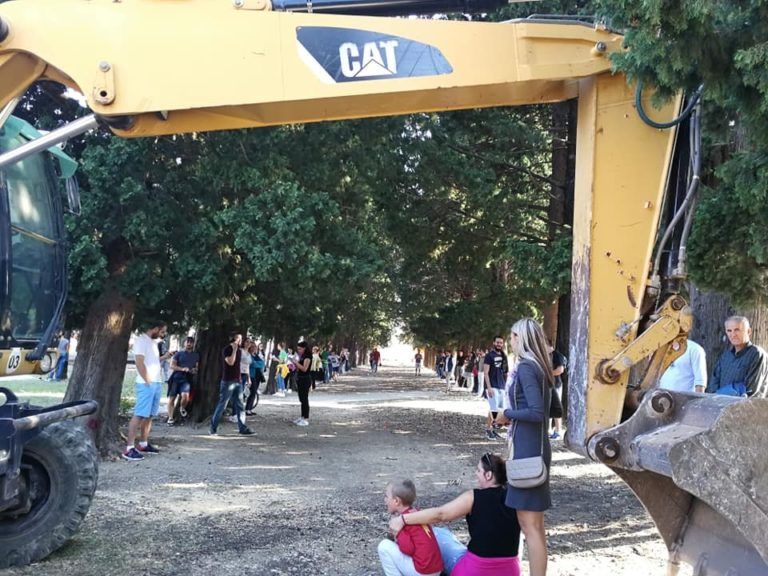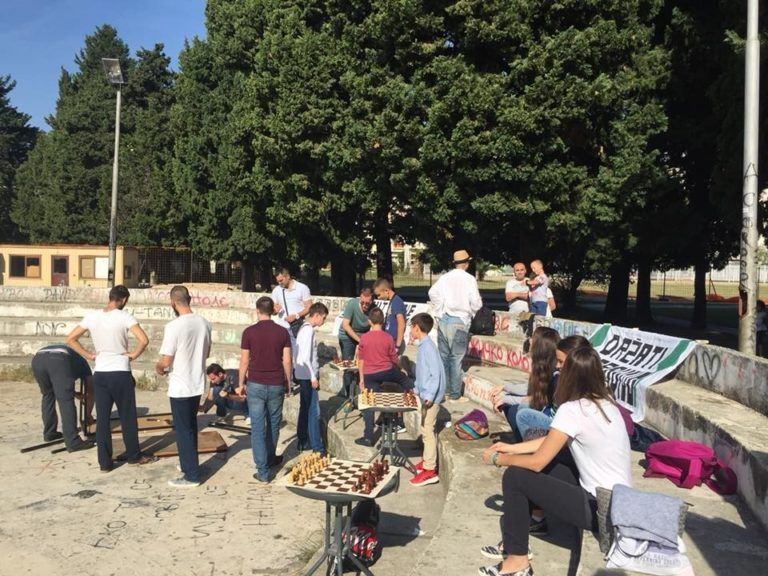January 29, 2019 - After three months of peaceful protests against a controversial construction project and in defense of preserving a nearly century-old cypress park in the center of Bar, a port city on Montenegro’s coast, it looks like the battle has been lost. However, Sonja Dragović tells us that the activists are not giving up - by responding to the government’s oppressive and deceitful tactics with hopeful, creative, and sustained acts of resistance, they keep trying to reclaim their right to the city, note the editors of LeftEast introducing the article published on 26 January
The Montenegrin town of Bar, an Adriatic Sea port, suffered a major loss last Thursday morning when around 90 cypress trees, almost 100 years old, were cut down in an attempt to clear a plot of land for the construction of a new kindergarten. This regrettable action is not, as it may initially seem, the result of a lack of space for much-needed new pre-school facilities, but a direct consequence of urban planning malpractices that have had a detrimental effect on the development of the entire country. In this particular case, the lack of accountability and transparency – together with systemic discouragement of meaningful public participation – produced a disastrous result. The only possible silver lining is the newly awaken energy of civil disobedience and communal solidarity rediscovered among the citizens of Bar, who are determined to stand up for their park, their schools, and the future of their city.
The works were announced on October 15 when Bar’s mayor, joined by the Minister of Education, set the foundation stone while casually noting that the new pre-school facility will be built between the buildings of two existing schools, where the old cypress park was located. Even though this face was announced as a matter-of-fact, not-to-be-discussed-any-further, the protests began almost immediately with a group of high school students starting to shout at the politicians participating in the ceremony, expressing their readiness to oppose the works and the implied destruction of their schoolyard, of which the park is an inseparable part.
 Human shields: citizens of Bar defending the cypress park. Photo: Anastasija Ivović
Human shields: citizens of Bar defending the cypress park. Photo: Anastasija Ivović
In the following days, the broader community began organizing in support of the cause. Human shields stopped the first attempt to cut the trees down, night watches were constantly organized, and a petition that asked for the park to be protected and for the new kindergarten to be moved elsewhere gathered more than 3,000 signatures. Meanwhile, students turned the protest into a festival dubbed “About Cypress Trees and People,” converting the park and the small amphitheater within its limits into a regularly occupied stage for local artists, debates, lectures, and workshops.
 Human shields: citizens of Bar defending the cypress park. Photo: Anastasija Ivović
Human shields: citizens of Bar defending the cypress park. Photo: Anastasija Ivović
Persistence paid off, at least temporarily, and the local parliament was persuaded into stopping the works and holding a special session to discuss the issue and vote on how to proceed. On November 15, the petition was dismissed - 14 opposition members of the local parliament supported the protesters, while the ruling majority did not: 7 were against their demands, while 13 were undecided. Activists agreed to continue advocating for their cause by using other legal instruments, primarily to examine the urban planning procedures that led to this outcome.
The plan for this construction project and everything it entailed was not new – it was only not discussed in public until the works were about to begin. The detailed urban plan which placed the kindergarten in the schoolyard was adopted in 2009 by the local parliament; upon closer inspection, it seems to be flawed, full of contradictions, and outdated. The building permit was first obtained in 2014 and renewed in 2017; it was issued even though the necessary documentation seems to be incomplete and the project itself is, to put it mildly, of dubious quality. All of these shortcomings have been discovered and publicized by local activists, who have submitted a request for inspection to the planning and construction authorities and filed an appeal to the Administrative court of Montenegro.
None of this really mattered. During the winter school break, while the procedures for assessing the validity of the plans were still ongoing, early in the morning of January 17, without warning, the trees in the cypress park were cut down. Since the official construction plan didn’t even account for this greenery (which was one of the shortcomings above), the authorities didn’t provide any official information on what portion of the park was to be destroyed, or why the works couldn’t wait for the official ruling on the citizen's appeals against this decision. Construction firms hired to do the job came from other cities. When the activists tried stopping them, the local police interfered and carried the protesters out of the park. According to activist’s accounts, 91 out of 127 cypress trees were cut down.
The damage Bar suffered is irreparable. The centrally located park provided protection from the strong sea winds and erosion, representing a natural oasis for the schoolyard and was, by all accounts, a beloved local landmark. So, why did this happen? In short, because it was convenient for the government, and because the wishes, needs, and long-term interests of the citizens are not the government’s prerogative. A longer answer would have to take into account flawed spatial planning procedures, which have for decades deliberately excluded people from the decision-making processes. The usual strategies of exclusion include lack of promotion for necessary public consultations, failure to provide the required materials in time and a format accessible to the broader audience, and the deliberate withholding of important (and possibly unpopular) facts. The goal is to have the consultative procedures formally fulfilled but essentially rendered meaningless, designed to confuse the wider public and discourage citizens from getting to the bottom of the planning process. What lies at the root is, of course, private interests - turning public space and public property into lucrative business opportunities for privileged individuals.
The case of Bar is not fundamentally different, even though the building in question is a public kindergarten – not a new tower built by some controversial “strategic investor,” as is usually the case. By placing the new pre-school facility for 400 children in the existing, already crowded schoolyard mostly used by high schoolers, the local government and the Ministry of Education have violated current planning rules and prescribed construction codes. Such a decision, however, was strategic - it preserved some other piece of publicly owned land in Bar for future, money-making construction projects. In this business calculus, a public park could only ever be a nuisance, an obstacle to getting rid of it – and that’s precisely what happened, common sense and the public interest be damned. One of the many sad ironies of this episode is that the construction of the future kindergarten is funded with a credit from the Council of Europe Development Bank, an institution whose Environmental and Social Safeguards Policy clearly states its commitment to promoting good environmental practices.
Source: LeftEast, author Sonja Dragovic








